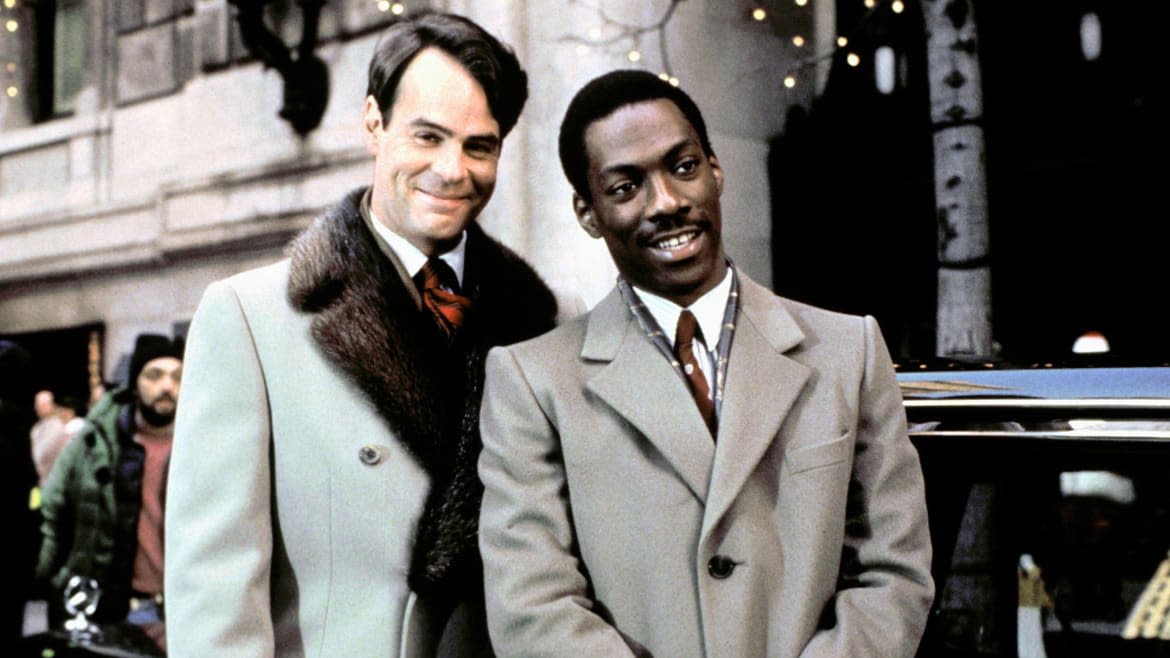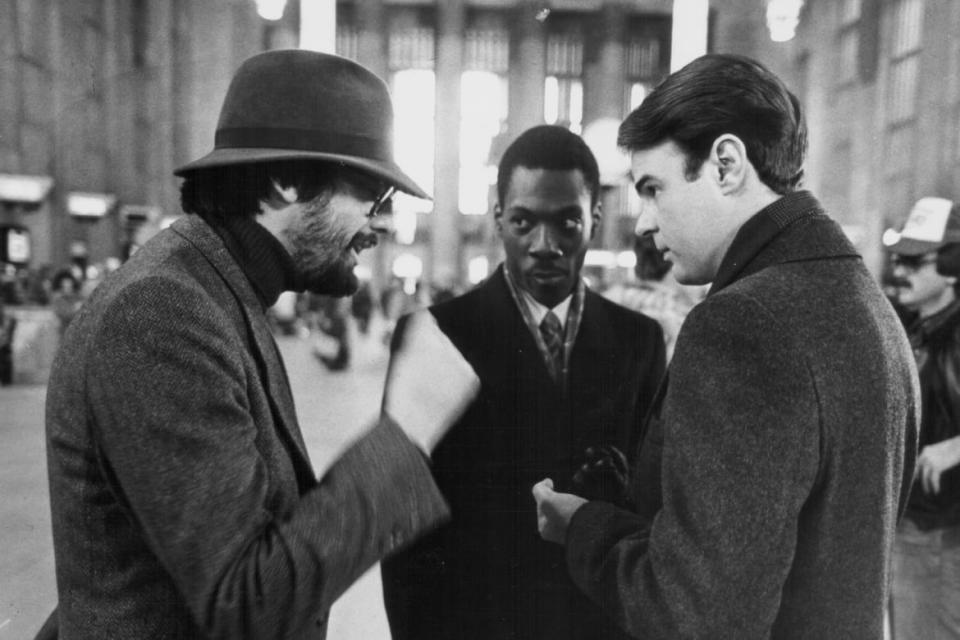‘Trading Places’ at 40: Dan Aykroyd Knows That Blackface Scene Wouldn’t Fly Today

- Oops!Something went wrong.Please try again later.
- Oops!Something went wrong.Please try again later.
- Oops!Something went wrong.Please try again later.
- Oops!Something went wrong.Please try again later.
- Oops!Something went wrong.Please try again later.
- Oops!Something went wrong.Please try again later.
It may be mid-June, but it’s never too early to think about Christmas—and one iconic festive movie has special reason to celebrate this year. Released in 1983, Eddie Murphy, Dan Aykroyd, and Jamie Lee Curtis’ status-swap comedy Trading Places turned 40 this month. Yep, despite its reputation as a yuletide favorite—thanks to the memorable image of Aykroyd’s grubby banker-turned-hobo dressed in a dirty Santa costume, drunkenly chewing on a salmon wedge—director John Landis’ comedy initially hit cinemas during peak summer, on the heels of blockbusters like Star Wars: Episode VI—Return of the Jedi and WarGames.
Following its June 1983 release, Trading Places became a huge hit, emerging as the fourth biggest box-office release of the year. In the four decades since, it’s been tirelessly reassessed with a more culturally sensitive lens, cementing a legacy as both an ’80s classic boasting comedy gold and a controversial relic of its time with bits that haven’t aged quite so well.
For at least one of its three leading stars, however, the film still holds a singular place in their storied filmography. “I count that movie as a triple-A,” says Aykroyd, speaking to us from the set of December’s as-yet-untitled Ghostbusters: Afterlife sequel. “It was intelligent and funny and had so much going for it. It was really satisfying.”
Dan Aykroyd on How Cocaine Fueled ‘The Blues Brothers’ and Aretha Franklin’s Iconic Performance
For the original Saturday Night Live cast member, Trading Places came at a pivotal time. Following early success with Landis’ 1980 hit The Blues Brothers alongside his SNL partner John Belushi, Aykroyd starred in less well-received romps like 1981’s Neighbors and 1983’s Doctor Detroit before wisely reteaming with Landis.
Trading Places starred Aykroyd as Louis Winthorpe III, a wealthy and pompous investor who swaps lives with a wily street-kid con artist named Billy Ray Valentine, played by then-SNL wunderkind Murphy. The switch is the result of a cruel bet orchestrated by harsh Wall Street millionaires Randolph (Ralph Bellamy) and Mortimer (Don Ameche), and to help recoup his high status, Louis recruits the help of a prostitute named Ophelia, played by Curtis. Together, the trio work to turn the tables on the snooty old guys responsible for their class-based crisis.
“I was approached by Paramount, as Eddie was, and basically recruited through executives at the studio,” Aykroyd recalls about landing the role. “I loved the part. [Herschel] Weingrod and [Timothy] Harris wrote that movie. They wrote it on a fax machine—one of them was in Michigan and one of them was in Los Angeles and they created pages by sending them back and forth.”
After Trading Places was released, it became such a big hit (earning over $90 million worldwide on a $15 million budget) that Murphy became one of the highest paid movie stars of the decade. Meanwhile, it paved the way for Curtis to break free of her Halloween horror links and Aykroyd to stroll right into impending Ghostbusters success just a year later.
“[Eddie] was just starting out and developing his comedic gift and comedic voice. To see and be a part of a talent emerging like that was part of film history,” Aykroyd says. “Jamie Lee Curtis and I became good friends too, and we remain so to this day.”
At the helm of it all was Landis, who became one of the pre-eminent comedy directors of the decade. Aykroyd pins the movie’s success squarely on Landis’ vision, and having worked with the director just three years prior on The Blues Brothers, he knew exactly what to expect on set.
“We were under the hand of a great director, so that always helps,” he says. “We also had the total backing of the studio, 100 percent, right up to its release. They were behind us all the way. I basically just did what [Landis] told me to. He’s very much an old-style director like Cecil B. DeMille. All that’s missing is the riding crop, the boots and the bullhorn.

“He’s an action director, so as far as leaning in and intimately giving notes on my performance, that’s not his style,” Aykroyd continues. “He expects you to come with your bags packed, knowing your lines and what tone and inflection to put into them, and if he wants to change something, he’ll shout it across the set. I always enjoy working with John because he’s a true cineaste. He understands better than many others I’ve worked with. He loves movies and made some great ones in his career.”
Despite being a financial and critical hit in 1983, though, the intervening years haven’t exactly been kind to Trading Places. While its comedy and nostalgia still resonate (it still holds solid scores on Rotten Tomatoes), it’s hard to overlook the film’s thornier details. For starters, there’s Curtis’ prostitute character, whose occupation has little consequence to the overall plot besides serving as eye candy for the primarily male cast. Could she have had literally any other job and delivered her role just the same? Probably.
Then there’s the casual racism and homophobia—a troubling hallmark of the time during which it was made. And while it’s amplified for comedic effect at the expense of the very characters using it, it still makes for uncomfortable viewing. For instance, the heavy insinuation of gorilla rape as comeuppance for Paul Gleason’s villainous Clarence is disturbing, but perhaps farcical enough to be played off as a gag.
The scene that isn’t as easily forgiven, however, involves Aykroyd’s costume choice during the film’s New Year’s Eve-set fancy dress finale.
“Well, I was in blackface in that film and I probably couldn’t get away with it now,” Aykroyd admits, reflecting on the scene where he appears as a Jamaican character, complete with dreadlocks and a Caribbean accent. “Eddie and I were improvising there. Eddie is a Black man and his entourage were all Black people, and I don’t think they batted an eye. There was no objection then; nobody said anything. It was just a good comic beat that was truthful to the story.”
That said, he concedes that the scene couldn’t be replicated today. “I probably wouldn’t choose to do a blackface part, nor would I be allowed to do it. I probably wouldn’t be allowed to do a Jamaican accent, white face or Black,” he suggests. “In these days we’re living in, all that’s out the window. I would be hard-pressed to do an English accent and get away with it. They’d say, ‘Oh, you’re not English, you can’t do it.’”
And speaking of memorable scenes, we had to ask: Did he really eat that salmon covered in dirty Santa beard hair?
“Of course I ate the salmon through the beard,” Aykroyd smiles. “Absolutely. Take after take, I can tell you.”
Despite its focus on the disparity between the rich and poor—a weighty theme that remains as topical and prevalent as ever these days—Trading Places has become one of those unlikely holiday classics that’s best enjoyed alongside the likes of Die Hard and Scrooged. As for its legacy 40 years later, Aykroyd is happy that the film has found its fans: “It’s right up there with It’s a Wonderful Life or A Christmas Story,” he tells us. “Trading Places is one of those films that people just love watching at Christmas. That’s when I hear about it most. I’m very proud of that one.”
Get the Daily Beast's biggest scoops and scandals delivered right to your inbox. Sign up now.
Stay informed and gain unlimited access to the Daily Beast's unmatched reporting. Subscribe now.

